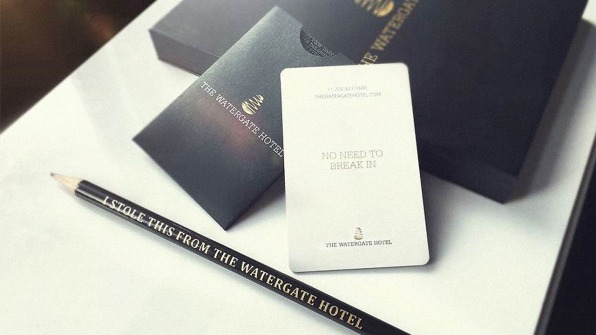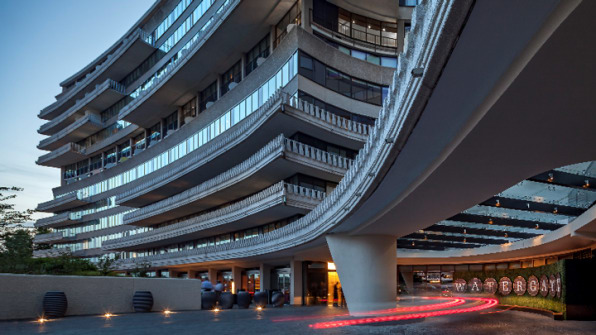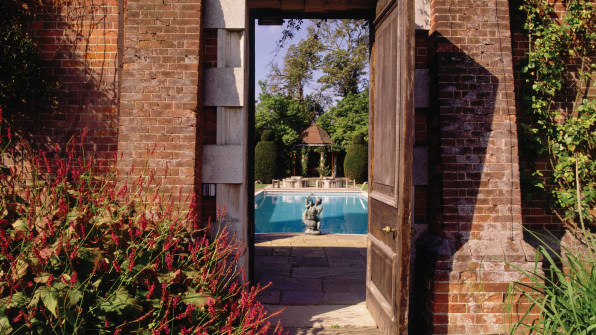Hotels are prime locations for scandal and intrigue, but embracing a controversial past can be a smart design move.
If ever there were a place for a scandal to play out, the darkened and discreet hotel room is it. Seedy hotels are probable spots for misconduct, obviously—but so are glamorous, distinguished hotels that host high-profile figures prone to high-profile screw-ups. For a prominent hotel, being the backdrop of a public scandal is forever an unavoidable possibility.
But how damaging to a hotel’s business is being swept up in a controversy it inadvertently hosted? By just providing the backdrop to a scandal, hotels are in the unique position of being able to capitalize on it without it seeming outright tasteless. Can a hotel’s unsavory history actually become its biggest branding asset?

The answer, according to Roberto Sablayrolles of the real estate and design firm Streetsense, is a resounding yes. Sablayrolles specializes in the experiential design of restaurants and hotels, so I called him up to ask how hotels handle controversial histories in their design and branding, starting with the Watergate—the hotel complex so defined by political scandal that its name has since become a suffix synonymous with public disgrace (see: Pizzagate, Bridgegate, Deflategate). Sablayrolles’s treated the break-in like a branding gift. “I have to tell you this, if we had the chance to do [the Watergate branding]it would have been great because there is already a great story there,” he tells me.Streetsense didn’t do the branding—Watergate developer Euro Capital did—but Sablayrolles says that any strong history that a hotel can use as its branding is an asset, especially one with as much name recognition as Watergate. “If you already have a story that’s controversial, there is a lot of opportunity for branding,” he says. In the Watergate’s case the flubbed burglary of the Democratic National Convention headquarters, located inside the complex, and subsequent cover-up by Nixon’s administration made the hotel an attraction even immediately afterward. According to the Washington Post, the scandal boosted business in the 1970s, and it continued to be used as a prominent spot for those in the Reagan administration in the 1980s. When the hotel closed down in 2007 it was because of building decline and changing ownership, not the bumbling burglary over 30 years prior.

Last June the Watergate reopened under new ownership with a $200-million renovation. In the press, the hotel branding took a backseat to the gilded, retro-chic interiors spearheaded by the British-Israeli designer Ron Arad. But the cleverest elements of the communication design are the ones that allude slyly to the scandal. Upon arrival, hotel attendants wearing uniforms designed by Mad Men costume designer Janie Bryant hand over key cards that affirm there is “No need to break in.” Pencils placed alongside a pad on the room desk read “I stole this from the Watergate Hotel.” For those really paying attention, the customer service phone number (1-844-617-1972) includes the break-in date, and the hotel’s typewriter-style typeface was inspired by the 1970s-era legal documents used during Nixon’s Senate hearings.
“I knew we needed to address the scandal, but I certainly didn’t want it to be the only focal point because the hotel is—and was—so much more glamorous than that,” says Rakel Cohen, who co-owns the hotel with her husband, Jacques Cohen, and led the hotel’s rebrand. The details Cohen included—she also points out that the front-desk hold music is a 1972 speech Nixon made to address Vietnam—are so subtle they feel like inside jokes, where the punchline is something everyone with the slightest knowledge of American history is in on.
In the same vein as the maxim “good design is invisible,” incorporating controversy takes a nuanced touch and a blending in with the overall design vision (in the Watergate’s case, an homage to its glamorous ’70s heyday). The fact that these references are so small they are totally missable is most of why they work. “If you explode a theme way too much it becomes over-theatrical,” says Sablayrolles. “That’s not clear branding. I like to say, when you have to tell the joke more than once, it’s not funny.”

The Watergate isn’t the only hotel that has been successful at spinning a big political scandal to its advantage. The website for the Cliveden House, a private estate-turned-luxury hotel in Buckinghamshire, U.K., boasts a history of “unapologetic debauchery” (which echoes the copy on the Watergate website promising “unapologetic luxury.”) The main piece of history the Cliveden House is not sorry for? The Profumo Affair, a 1961 political scandal that started with an affair between John Profumo, the secretary of state for war at the time, and 19-year-old model Christine Keeler and ended with the resignation not only of Profumo but also of British Prime Minister Harold Macmillan. Profumo and Keeler began their relationship after meeting by the pool at a Cliveden estate party, where Keeler was swimming in the nude.

These days, the secluded pool is now a spa area, and the hotel’s copy is replete with mentions of decadence and intrigue. “Cliveden absolutely embraces its scandalous history,” says managing director Andrew Stembridge. “It is indeed the hotel’s past that defines the property today, making it one of the most historically renowned hotels in the world.” He points out that political scandal stretches even further back than Profumo, all the way to 350 years to when the Cliveden House was first built. In 1666, the second duke of Buckingham had the house built as a gift to his mistress, the countess of Shrewsbury.Advertisers and designers have long known that sex and scandal sell, and clever hotel branding can play that up. As Sablayrolles puts it, the clever details can provide what he calls “Instagrammable moments,” but they have to be rooted in a more compelling overarching story. With hotels, there’s a fine line between sexy and seedy—it takes a historical foothold and a nuanced approach to come off as the former.
–
This article first appeared in www.fastcodesign.com
Seeking to build and grow your brand using the force of consumer insight, strategic foresight, creative disruption and technology prowess? Talk to us at +9714 3867728 or mail: info@groupisd.com or visit www.groupisd.com


